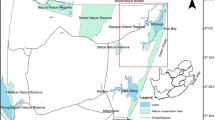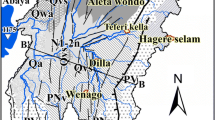Abstract
The aim of the study is to investigate the interaction between waters of Lake Girdev and groundwater in the allochthonous limestone units exposed in the area between Lake Girdev and Kazanpınarı Spring, southwestern Turkey. The features analyzed include the flow direction and apparent groundwater velocity, their relationship with Lake Girdev, and the effect of lithological and structural features on the groundwater circulation. The results of a fluorescein tracer test indicate that groundwater flows east-northeast and the apparent flow velocity ranges from 26.2 to 35.6 m h–1 between the injection site and various observation points. Tritium data suggest that the water of Lake Girdev and groundwater are probably similar in age, and oxygen-18 isotope data indicate that water derived from Lake Girdev is the main source of recharge to the aquifer. The aquifer is fed not only by Lake Girdev but also by rainfall percolating through allochthonous limestones; together, these provide the discharge of springs in Elmalı Polje. The permeability of the allochthonous limestone aquifer has been enhanced as a result of jointing and faulting.
Résumé
Cette étude avait pour but d'analyser les relations entre les eaux du lac Girdev et les eaux souterraines des unités calcaires allochtones affleurant dans la région comprise entre le lac Girdev et les sources de Kazanpinari (sud-ouest de la Turquie). Les phénomènes étudiés concernent la direction de l'écoulement et la vitesse apparente de l'écoulement souterrain, les relations avec le lac Girdev et le rôle de la lithologie et de la structure sur les écoulements. Les résultats d'un traçage à la fluorescéine indiquent que l'eau souterraine s'écoule vers le nord-est et que la vitesse apparente moyenne est comprise entre 26.2 et 35.6 m h–1, entre le point d'injection et les différents points d'émergence. Les données de tritium suggèrent que l'eau du lac de Girdev et l'eau souterraine ont probablement le même âge; les données d'oxygène-18 indiquent que l'eau du lac Girdev est la principale alimentation de l'aquifère. L'aquifère est alimenté non seulement par le lac Girdev, mais aussi par les précipitations alimentant l'infiltration dans les calcaires allochtones; ces deux types de recharge assurent l'écoulement aux sources du poljé d'Elmalı. La perméabilité dans l'aquifère des calcaires allochtones a été interprétée comme étant due aux fissures et aux failles.
Similar content being viewed by others
Author information
Authors and Affiliations
Additional information
Received, June 1997 / Revised, June 1998, March 1999 / Accepted, July 1999
Rights and permissions
About this article
Cite this article
Çelik, M., Ünsal, N. Groundwater circulation in the allochthonous limestone units between Lake Girdev and Kazanpınarı Spring, Antalya, southwestern Turkey. Hydrogeology Journal 7, 483–489 (1999). https://doi.org/10.1007/s100400050221
Issue Date:
DOI: https://doi.org/10.1007/s100400050221




